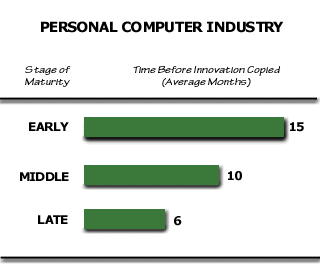THE DANGER OF COMPETING ON FEATURES
by Donald V. Potter
When a customer buys, his first consideration is always function — that is, what a product or service does. For a supplier, then, it seems logical to concentrate on functionality. Why not invest to ensure that your company is first with new features?
Yet a paradox exists. While function may be customers’ first consideration, function leadership may not be the best investment choice for suppliers. The key question is: “Will the reward for a unique new function justify the cost of being first?”
When is Function Decisive?
“Customers who really value technological advances may be numerous, but often bring little volume.”
Customers choose a supplier by stepping through a hierarchy of requirements. First, they consider function. Any supplier that does not offer the customer’s required minimum set of features will be eliminated from consideration. But, once this minimum is met, customers move on to consider reliability, convenience, and finally price.
What causes a customer to base his buying decision on function, without going on to consider other factors? The feature behind the function must be of real value to the customer, so valuable that he will not buy a product that does not have it. If the function’s value is not recognized, or if it is seen as merely “nice to have”, the customer will set it aside and make his buying decision on another factor. Furthermore, the function must be unique, that is, available from only one supplier. Once a second supplier duplicates the function, the buyer can no longer choose between the two suppliers on function but must move to another basis, such as reliability.

Three Questions For Suppliers
“Rewards do not necessarily go to the market leader.”
Before investing to develop leading-edge features, a supplier should consider whether that investment will pay back in the marketplace. The key questions are:
- Will the feature attract sufficient volume?
Of course, every function that could be developed or even imagined should be of value to some customers. But to how many? Do these customers constitute a sufficiently large segment of the market? Especially in mature markets, customers who really value the latest technological advance tend to be vocal, may be numerous, but they often bring little volume. - Can the feature be copied easily?
Suppose one supplier introduces a feature that has broad customer appeal. Typically, share begins to shift. Then competitors try to match the innovation.Many feature innovations are easy to duplicate. Product features can be reverse engineered, revealing their secrets to competitors. Many service innovations, while more challenging, can also be easy to copy. Airline frequent flier programs and credit card “Buyer Protection Plans” are examples of service innovations that quickly became ubiquitous. Function innovations are duplicated faster as a market matures.
- Does the market reward the leader?
Furthermore, the rewards do not necessarily go to the market leader. Few markets are so innovation sensitive that customers will wait for the latest new feature, then buy immediately before competitors have the chance to match that feature.- An innovation may be ahead of market need, solving problems that people don’t yet realize they have. Then, the leader must invest in creating demand for the new feature. For example, U.S. companies were making fax machines twenty-five years ago. Few customers felt they needed a fax then. Creating demand adds to the cost of a new feature while giving competitors time to match the innovation.
- Or, the market may expect each new feature to be copied quickly by all major suppliers. If buyers like the new feature but do not need it immediately, they can wait for their established, and probably more convenient, supplier to match the innovation.
Function Leadership is No Panacea
Function leadership makes sense when the new feature is of real importance to a sufficiently large segment of the market, and when the leader can maintain uniqueness long enough to justify its investment. These conditions can exist, and sometimes function leadership is warranted and wise. But adding features is not usually an easy solution to gaining or retaining share in a hostile marketplace.
Closing Thought
In hostile markets many mangers turn naturally to feature innovations to gain share and, perhaps, raise prices. But prices usually don’t go up, and functional differences, all combined, usually command less than 20% of a hostile market’s volume.
(Note: This Perspective was written in the context of the economy in 1992. While some of the companies may have changed their policies or indeed no longer exist, the patterns they exhibit still hold today.)
| Recommended Reading |
| For a greater overall perspective on this subject, we recommend the following related items:
Analyses:
*** |
